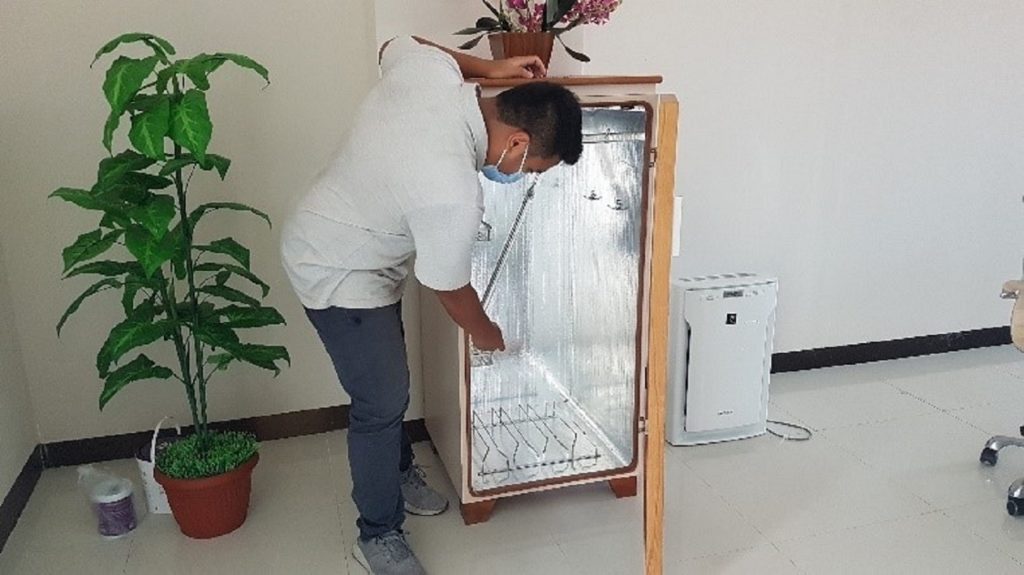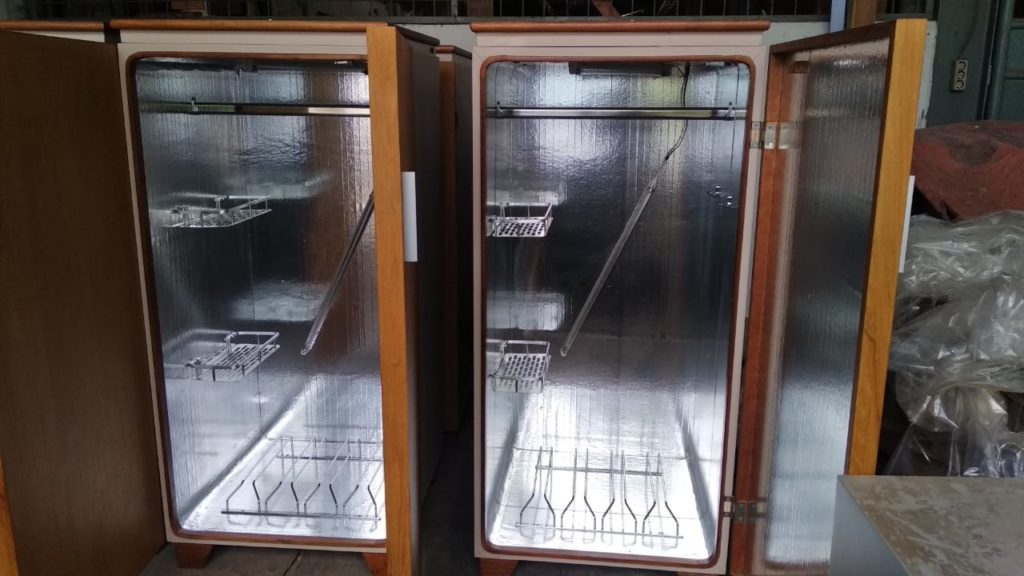ITS Abmas Team Designs UV-C Disinfectant Cabinets for Health Centers

(from left) Anggra Ayu Rucitra ST MMT, Dr. Mahendra Wardhana ST MT, Caesario Ari Budianto ST MT, Okta Putra Setio Ardianto ST MT, and Thomas Ari Kristianto SSn MT as a team of lecturers from the Abmas Team of the ITS Interior Design Department
ITS Campus, ITS News – The Academic Community of the Institut Teknologi Sepuluh November (ITS) has never stopped producing ideas and innovations during the current pandemic situation. This was evidenced by the Thematic Community Service Team (Abmas) from the ITS Interior Design Department, who succeeded in designing a product for personal protective equipment (PPE) disinfectant cabinets based on Ultraviolet C (UV-C) rays for health centers.
The Academic Community of the Institut Teknologi Sepuluh November (ITS) has never stopped producing ideas and innovations during the current pandemic situation. This was evidenced by the Thematic Community Service Team (Abmas) from the ITS Interior Design Department, who succeeded in designing a product for personal protective equipment (PPE) disinfectant cabinets based on Ultraviolet C (UV-C) rays for health centers.

(from left) Members of the student team consisting of Zahra Ayudhia Pawestri, Nabila Izzati Jannah, and Ailsashofa Alfadhila from the Abmas Team of the ITS Interior Design Department
The team leader, Caesario Ari Budianto ST MT, explained. Currently, PPE equipment for health workers (nakes) is one of the most critical factors in preventing and controlling Covid-19 infections. However, the availability of PPE at the puskesmas is considered unable to meet the need for PPE, coupled with the absence of PPE cleaning facilities that allow it to be reused.
The lecturer, who is familiarly called Rio, explained that from these problems, the idea emerged to make PPE disinfectant tools to utilize PPE, which can be used more than once. With this, Rio said that the waste of PPE can be prevented so that its use can be more efficient. “Then from the results of the study, we chose the Jetis Health Center in Ponorogo Regency to have the right to use this disinfectant cabinet,” he added.
Meanwhile, according to Rio, UV-C technology was chosen because UV-C rays can naturally break down several kinds of bacteria and viruses. UV-C itself has been known as an intermediate disinfectant for the sterilization process of tools. However, UV-C cannot be directly exposed to humans, only limited to objects in the process.

When the UV-C-based disinfectant cabinet by the Abmas Team of the ITS Interior Design Department was tested
In addition, he continued, the nature of UV-C, which converts the air it irradiates into Ozone (O3), is dangerous if inhaled. However, once deactivated, the Ozone-rich air will split back into hydrogen atoms in a short time. “From these considerations, we can conclude that the use of UV-C is quite safe and easy to control,” he explained.
One of the team members, Okta Putra Setio Ardianto ST MT revealed, this disinfectant cabinet is unique because, in its manufacture, it also pays attention to aesthetics and ease of use. This cabinet is designed with wood material on the exterior so that the design is not rigid like fabricated products in general. “This product is made to look like a piece of furniture that becomes one with the room,” he explained.
In terms of ease of use, this cabinet is equipped with a simple button interface and adjusted according to needs. In total, there are three buttons, each of which is used to turn on the cupboard within 5 minutes, 10 minutes, and 15 minutes. “Users just turn on the cabinet by pressing the button according to their preferences, then just wait for the cleaning process to finish and turn off by itself,” he added.

The UV-C-based disinfectant cabinet by Tim Abmas from the ITS Interior Design Department is visible from the front.
The combination, according to Okta, makes this disinfectant cabinet psychologically give a warm impression when viewed and makes the health workers more relaxed at work. When the wardrobe design was shown for the first time to the health workers at the Jetis Health Center, it seemed like a surprise because the plan was not as imagined. “They said it was good. It didn’t look like a normal medical device. It was even placed in a room near the service room,” said Okta.
Okta explained that when it was first sent to the Jetis Health Center, his team had time to conduct briefings and short verbal training regarding the guidelines for using the disinfectant cabinet to the health workers of the Jetis Health Center. Because of its easy use, Okta said that the health workers did not encounter any difficulties when the cabinet was used and tested for the first time.
In the end, Rio and the team will consider the feedback given by the health workers to this disinfectant cabinet during its operational period at the Jetis Health Center. From there, he wants the next model of the disinfectant cabinet to be made more compact, more straightforward, and can be disassembled to facilitate mobility. “This is by our goal to make all circles of society can enjoy this product,” he said. (ITS Public Relation)
Reporter: Ferdian Wibowo
Related News
-
Anticipating Lost Pet Dogs, ITS Students Invent a Tracking Bag
ITS Campus, ITS News —Losing a pet is a sad thing for its owners. To anticipate this, a team
October 22, 2021 19:10 -
ITS Students Integrate Smart City Service Features Through Visionaries
ITS Campus, ITS News — Institut Teknologi Sepuluh Nopember (ITS) continues to prove itself as a home for talented
October 22, 2021 19:10 -
ITS Students Innovate Eco-Quake Building Concept
ITS Campus, ITS News — Along with the development of technology, the construction sector has also experienced rapid growth
October 22, 2021 19:10 -
Great, ITS Successfully Becomes Overall Champion of the 2024 Indonesian Ship Contest
ITS Campus, ITS News — Proving itself as a home for champions, Institut Teknologi Sepuluh Nopember (ITS) managed to
October 22, 2021 19:10
